Indus Valley Civilization Origin, Architecture, Religion, Location, Trade, Politics, Scripts, Art and Crafts, Decline
1. Origin
- Harappan Civilization, also known as Indus Valley Civilization, had flourished across the area of the North-Western part of the Indian subcontinent around 2500 BC.
- It is one of the oldest and greatest civilizations of mankind. It flourished from around 2500 BC to 1750 BC.
- The story of the Harappan Civilization begins with the Harappan seal, which was noticed by British officer A. Cunningham in 1853.
- In 1921 Daya Ram Sahni, an Indian Archaeologist had started the excavation of Harappa and R D Banerji had started the excavation of Mohenjodaro.
- John Marshall carried out a large-scale excavation at Mohenjodaro in 1938.
- It has got the name of Harappan Civilization from its first discovered site ‘Harappa’ in the Punjab province of Pakistan in 1921.
2. Geographical extent of Indus Valley Civilization
- It spreads over the region of Punjab, Sindh, Northwest Frontier Province, Baluchistan, Rajasthan, U.P, Gujarat and some parts of South India.
- Important centers of Harappan Civilization are Harappa, Mohenjodaro, Kalibangan, Lothal, Dholavira, Rakhingarhi, Kot Diji, Chanhu-daro, etc.
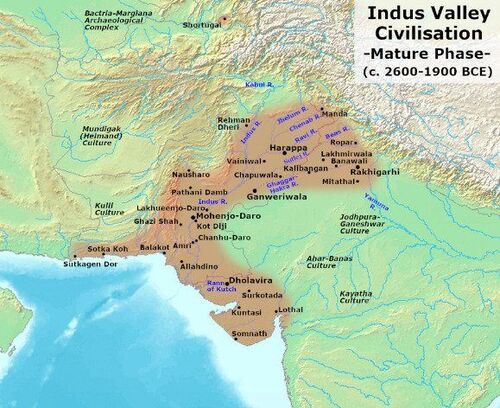
(Source: Wikipedia)
| Easternmost site of Harappan Civilization | Alamgirpur | Uttar Pradesh |
| Westernmost site of Harappan Civilization | Sutkagen Dor | Pakistan |
| Northernmost site of Harappan Civilization | Manda | Jammu Kashmir |
| Southernmost site of Harappan Civilization | Daimabad | Maharashtra |
3. Archaeological findings at important centers
- Harappa (Pakistan): Two rows of six granaries, Graveyard, stone symbol of a lingam, Coffin burial
- Mohenjo-Daro (Pakistan): Great Granary, Great bath, Mother Goddess, Pashupati seal, Statue of a dancing girl, Painted seal
- Kalibangan (Rajasthan): Evidence of earthquake, wooden plough, decorated bricks, Camel’s bone
- Lothal (Gujarat): Evidence of Rice, Ivory weight balance, dockyard
- Ropar (Punjab): Dog buried with humans
- Rakhigarhi (Haryana): Couple’s grave’
- Banawali (Haryana): Toy plough
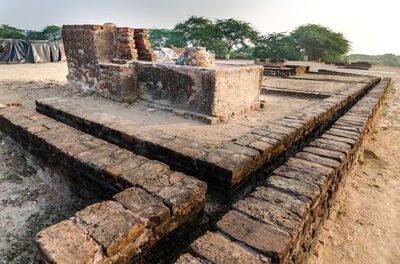
(Fig: Lothal Dockyard)
Quiz
Quiz of Indus Valley Civilizations
Attempt Quiz4. Features of Harappan Civilization:
Town planning in Harappan Civilization
- Archaeological evidence shows that the cities were planned in a grid format. In this system of planning, streets cut each other at the right angle and there was a drainage system for the whole city.
- Citadel was built on a raised platform, comprising granaries, religious buildings, public buildings, and assembly halls. The higher class of society resides around the citadel.
- Houses were built on both sides of the streets. Burnt bricks and Sun-dried bricks were used for the construction.
- Chanhudaro was the only Indus Valley city without a citadel.
Agriculture in Harappan Civilization
- It was the backbone of the Harappan economy.
- The main food crops produced were wheat, barley, rice, lentil, peas, cotton, sesame and mustard.
- They also knew the use of sickle and used to cut crops with it. The surplus produce was stored in the granary.
- Cattle-rearing was also performed by the people of this Civilization. They used sheep, goats, humped bull, dogs for their work.
Great Bath in Harappan Civilization
- It is the most important structure of Mohenjodaro.
- It is surrounded by corridors on all sides and is approached either end by a flight of steps in north and south.
- In this bath, water was supplied from the adjacent room and it had a drain for the outlet of water.
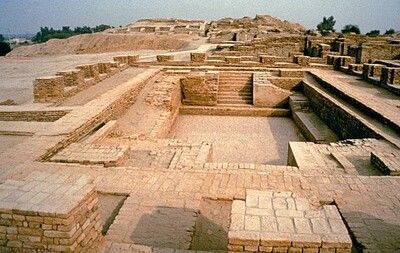
(Fig: Great Bath of Mohenjodaro)
(Source: Harappa.com)
Trade and commerce of Harappan Civilization
- The evidence of numerous seals, granaries, uniform script depicts that trade played a significant role in the economy of the Harappan Civilization.
- The traders of this Civilization had contact with the foreign lands for the goods, which were not available locally.
- Harappan civilization people exported Agricultural products, cotton goods, terracotta figurines, pottery, certain beads, ivory products, copper, etc. They imported Gold, silver, copper, Tin, steatite, etc.
- They used the barter system by carrying out exchanges. Metal money was not used by them.
- They had foreign trade with Mesopotamia (Present Iraq), Persia, and China.
5. Religious Beliefs and Practices
- The religion of Harappan Civilization is termed animism; it means they worship trees, stones, nature, earth, etc.
- The mother goddess is the important god of this Civilization. The evidence of worship of linga (phallus) and yoni (female sex organ) has also been found.
- The male chief deity present on a seal with a buffalo-horned head-dress, sitting in a yogic posture and surrounded by animals is identified as ‘Proto-Shiva’ or Pashupati (lord of animals).
- Evidence of fire worship has been found at Kalibangan and Lothal.
- Tree and animal worship was also practiced by the people of the Harappan Civilization.
- No religious structure has been found from any of the sites of the Harappan Civilization.
6. Harappan Script
- The complete Harappan script was found in 1923, but it is still not deciphered.
- The script was written from right to left and it comprises 400 signs. It has also used pictographs for representing words, sound, ideas or object.
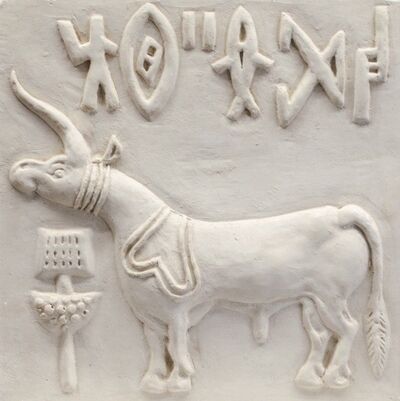
(Fig: Harappan seal)
7. Harappan society
- It had been primarily a matriarchal society.
- It was comprised of people from different professions such as warriors, peasants, traders and artisans.
- Ruling class peoples lived around the citadel and the common people live in the lower part of the city.
- Harappan peoples were fond of ornaments; they use necklaces, armlets, earrings, beads, bangles, etc. They use cotton and woolen clothes for wearing.
8. Political structure of Civilization
- There is no clear evidence of the political structure of the Harappan Civilization, but from some evidence, it is assumed that people living around Citadel were the ruling class of the city.
- The middle portion of town may have been the areas of bureaucrats, who helped the ruling class in ruling the cities.
9. Art and Crafts of Harappa
- Harappan Civilization belongs to the Bronze Age, so people used tools and implement made up of stone. They were aware of almost all the metals except iron.
- The common tools used by them were axe, saws, chisels, knives, spearheads and arrowheads.
- They were well-known for the use of bronze. A bronze dancing girl from Mohenjodaro gives evidence of the use of bronze.
- The evidences of bead making are also found from Chanhudaro and Lothal.
- A large number of terracotta figurines were found from the different sites of the Harappan Civilization. They represent birds, dogs, sheep, cattle, etc.
- They used the potter’s wheel for making pots of different colours and designs.
- A bearded man sculpture discovered at Mohenjodaro is one of the most famous stone sculptures of the Harappan Civilization.
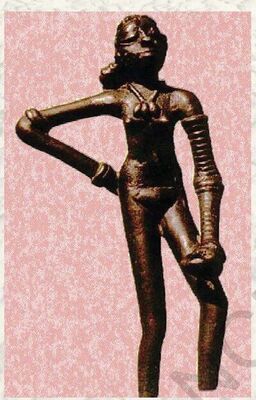
(Fig: Bronze dancing girl)
(Source: NCERT)
10. Decline of Harappan Civilization
- It existed between 2500 BC-1750BC and the decline of the Harappan Civilization was gradual.
- There were many theories about the decline of the Harappan Civilization. Many factors led to the decline of the Harappan Civilization.
Theories of decline of Harappan Civilization
- Some scholars suggested that floods and earthquakes might be the reason for the decline.
- Another theory depicts that civilization end due to the drying of rivers. It led to arid conditions in the region around 2000 BC.
- The Aryan invasion theory is also given by some scholars.
Current Facts related to Harappan Civilization:
- According to IIT-Kharagpur drought wiped out Indus civilization.
- A team of scientists and academics are using the computed tomography (CT) technique to recreate the faces of Rakhigarhi skulls.
- A world-class museum will be built at Rakhigarhi.
- A team of geotechnical engineers from IIT-Gandhinagar and the Archaeological Survey of India (ASI) has discovered a water-harvesting system structure in Dholavira.
- DNA samples of skeletal remains excavated from Rakhigarhi have raised doubt on the theory of Aryan invasion.
- India’s first National Maritime Museum will be built in Lothal.
Summary
Origin
- Flourished from 2500 BC to 1750 BC.
- Excavation started by Daya Ram Sahini in 1921.
- Got the name from the city Harappa.
Geographical extent
- North-Western part of the Indian subcontinent.
- Region: Punjab, Sindh, northwest Frontier Province, Baluchistan, Rajasthan, U.P, Gujarat.
- Important centers: Harappa, Mohenjodaro, Kalibangan, Lothal, Dholavira, Rakhingarhi.
Features
- Grid format town planning
- Citadel built on a raised platform of the city
- Agriculture was the backbone of the economy
- Main crops: wheat, barley, rice, lentil, mustard, peas, cotton, sesame and mustard
- Animals used are sheep, goat, humped bull, dog
- The great bath was an important structure of Mohenjodaro
- Traders have foreign contact with Mesopotamia, Persia, and China
- Export: Agricultural products, cotton goods, terracotta figurines, pottery, certain beads
- Imports: Gold, silver, copper, Tin, steatite
- Harappan script is not deciphered
Religious Beliefs and Practices
- Mother goddess and Proto-Shiva important gods
- No religious structure has been found
- Believed in the worship of trees and Animals
Harappan society
- Matriarchal society
- Different class people lived
Art and Crafts of Harappa
- Know all metals except Iron
- Bronze dancing girl and bearded man sculpture found from Mohenjodaro
- Use different design pottery
Decline
- The gradual decline from 1900 BC
- Many factors for the decline including flood, earthquake, forest fire, Drought, Aryan invasion, etc
Frequently Asked Questions (FAQs) about Indus Valley Civilization
Which are the prominent sites of Harappan civilization?
Important centers of Harappan civilization are Harappa, Mohenjodaro, Kalibangan, Lothal, Dholavira, Rakhingarhi, Kot Diji, Chanhu-daro, etc.
Who are the important gods of Harappan civilization?
The mother goddess and Proto-Shiva are the important gods of this civilization.
Which Crops are produced by the peoples of Harappan civilization?
They mainly produce wheat, barley, rice, lentil, mustard, peas, Cotton, sesame and mustard.
What are the major cause of decline of the Harappan Civilization?
There were many factors which led to the decline of Harappan civilization such as flood, earthquake, drought, Aryan Invasion, etc
Which harappan site is famous for the dockyard?
The most unique feature of Lothal is the dockyard, which is present in eastern part of the site.
Which is the southernmost site of Indus Valley Civilization?
The southernmost site of Indus Valley Civilization is Daimabad, Maharashtra.




 Latest
Latest 



Comments